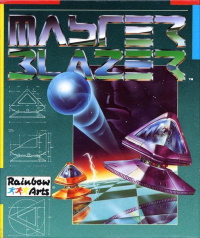 Amiga cover art | |
| Developer(s) | Rainbow Arts |
|---|---|
| Publisher(s) | Lucasfilm Games |
| Designer(s) | Gero Presser [1] |
| Composer(s) | Chris Hülsbeck [1] Jochen Hippel (ST) |
| Platform(s) | Amiga, Atari ST, MS-DOS |
| Release | 1990 |
| Genre(s) | Action |
| Mode(s) | Single-player |
Masterblazer is a video game developed by Rainbow Arts and published by Lucasfilm Games in 1990 for the Amiga, Atari ST, and MS-DOS. It is the sequel to the 1985 game Ballblazer . [1]
Masterblazer presentes a futuristic sport where the playing field is a large rectangle made of squares. [1] A Plasmorb ball must be moved into a goal as many times as possible within the course of three minutes. [1] This is accomplished by using a Rotofoil vehicle. [1] Unlike its predecessor, the game features a tournament mode which allows up to 8 players to compete for the Master Blazer prize. [2] This game also allows Rotofoils to race against each other (basically a normal game but without the ball). [1]